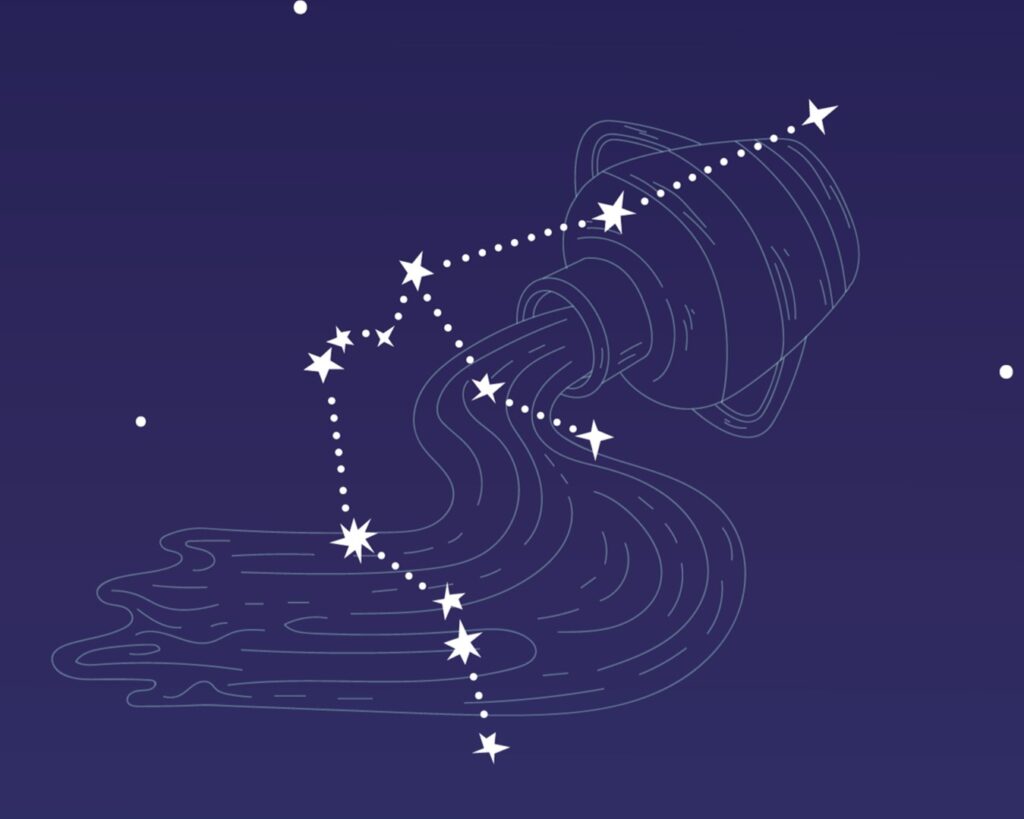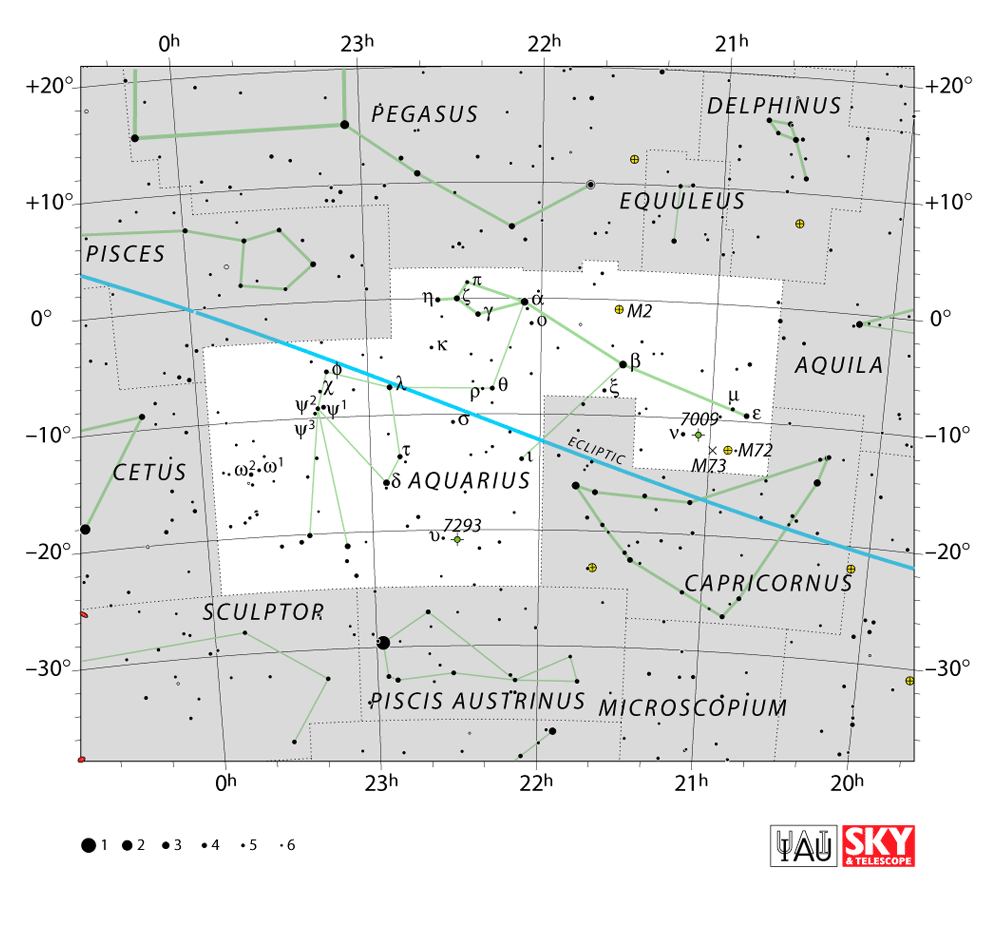Stargazing with Aquarius
© freepik/tartila
The constellation Aquarius, one of the 88 officially recognized constellations in the night sky, is a celestial region rich in mythology and astronomical wonders. Positioned in the southern hemisphere, Aquarius is commonly associated with the Water Bearer from ancient Greek mythology. It is found in a region often called the Sea due to its profusion of constellations with watery associations such as Cetus the whale, Pisces the fish, and Eridanus the river. At apparent magnitude 2.9, Beta Aquarii is the brightest star in the constellation.
This zodiacal constellation holds cultural significance and has been observed and studied throughout human history. From its distinctive asterism to the deep-sky objects it harbours, Aquarius invites both astronomers and stargazers to explore its cosmic beauty and unravel the mysteries of the celestial realm.
HISTORY OF AQUARIUS

The constellation has a rich history deeply intertwined with mythology and cultural narratives. Its origins can be traced back to ancient civilizations that gazed upon the night sky, finding inspiration in the patterns formed by stars. In Greek mythology, Aquarius is often associated with Ganymede, a beautiful youth whom Zeus transformed into an eagle and placed among the stars. Ganymede became the cupbearer to the gods, pouring water from a pitcher—an image that eventually led to the association of Aquarius with the Water Bearer.
In Babylonian astronomy, Aquarius was linked to the god Ea, known as the god of wisdom and water. The Babylonians associated this constellation with their annual flooding of the Euphrates River, a phenomenon vital for their agricultural practices.
The ancient Egyptians also recognized the constellation, depicting it as a figure pouring water. In their cosmology, this act symbolized the annual flooding of the Nile River, crucial for their agriculture and marking the beginning of the new year.
During the Hellenistic period, the Greek influence on astronomy led to the formalization of Aquarius as a distinct constellation. The work of the renowned astronomer Ptolemy in the 2nd century further solidified its place in the Western astronomical tradition.
ASTRONOMICAL FEATURES

The constellation Aquarius boasts several notable astronomical features, ranging from stars and asterisms to deep-sky objects. Here are some key elements within the celestial canvas of Aquarius:
ASTERISM
The Water Jar, or “The Urn,” is an asterism within the Aquarius constellation that holds cultural and mythological significance. Comprising a distinctive pattern of stars, this celestial arrangement is often associated with the mythological image of Aquarius, the Water Bearer, pouring celestial waters. Positioned within the larger Aquarius constellation, The Water Jar serves as a visual guide for skywatchers and astronomers identifying this zodiacal region. Its appearance in the night sky contributes to the unique charm of Aquarius, inspiring imagination and connecting observers to the rich tapestry of myths and stories woven into the constellations.
BETA AQUARII
Sadalsuud, designated as Beta Aquarii, stands as a prominent star within the Aquarius constellation, marking its alpha star. Positioned approximately 610 light-years away from Earth, Sadalsuud shines as a yellow supergiant, contributing to the constellation’s luminosity. Its name is derived from the Arabic phrase meaning “luckiest of the lucky,” reflecting its significance in the night sky. As one of the brighter stars in Aquarius, Sadalsuud captivates observers with its radiant presence and serves as a stellar landmark within the celestial expanse. Its role in the intricate patterns of Aquarius adds to the constellation’s allure and invites sky enthusiasts to explore this captivating region of the cosmos.
EPSILON AQUARII
Epsilon Aquarii, also known as Albali, is a binary star system situated in the Aquarius constellation. This intriguing celestial pair consists of a yellow giant and a white dwarf, engaged in a captivating stellar dance. Albali’s components share an intricate cosmic connection, showcasing the dynamic interactions within stellar systems. Positioned within the larger tapestry of Aquarius, Epsilon Aquarii contributes to the constellation’s celestial beauty and offers astronomers and stargazers an opportunity to study the diverse and fascinating nature of binary star systems in our night sky.
XI AQUARII
Ganymede’s Star, designated as 51 Aquarii, is a binary star system nestled within the Aquarius constellation. This celestial duo consists of a pair of yellow-hued stars, contributing to the constellation’s overall radiance. Ganymede’s Star adds to the diverse stellar population within Aquarius, inviting skywatchers to explore its luminous presence. The name alludes to Ganymede, a figure from Greek mythology, emphasizing the rich cultural tapestry woven into the celestial realm. As part of the intricate cosmic mosaic of Aquarius, Ganymede’s Star captivates observers and underscores the astronomical wonders embedded in this zodiacal constellation.
MESSIER 2
Messier 2 (M2) is a remarkable globular cluster located in the constellation Aquarius. Positioned approximately 37,000 light-years away from Earth, M2 is one of the older and larger globular clusters in our Milky Way galaxy. Comprising densely packed stars, M2 forms a spherical shape, exhibiting a captivating arrangement of stellar brilliance. Charles Messier included it in his catalogue in 1760, recognizing its distinct appearance. Observing Messier 2 through telescopes reveals a stunning concentration of stars, offering astronomers insights into the dynamics and evolution of such stellar clusters.
MESSIER 72
Messier 72 (M72) stands as a globular cluster nestled within the boundaries of the Aquarius constellation. Situated around 53,000 light-years away from Earth, M72 is a dense collection of stars orbiting the center of our Milky Way galaxy. Charles Messier catalogued this celestial gem in 1780, acknowledging its unique characteristics. Observing M72 through telescopes reveals a spherical congregation of stars, showcasing the intricate beauty of globular clusters. As a distant and intriguing component of Aquarius, Messier 72 contributes to the constellation’s cosmic tapestry, providing astronomers and stargazers with a captivating target for exploration and admiration in the night sky.
HELIX NEBULA
The Helix Nebula, also known as NGC 7293, is a striking planetary nebula located in the constellation Aquarius. Positioned around 700 light-years away from Earth, this celestial beauty earned its name due to its resemblance to a giant eye or helix. The Helix Nebula is formed by the outer layers of a dying Sun-like star expelled into space, creating a stunning cosmic display. It’s intricate structure and vibrant colors make it a favorite among astronomers and astrophotographers.
VISIBILITY AND SEASONALITY

The visibility and seasonality of the Aquarius constellation make it a captivating subject for sky enthusiasts and astronomers alike. Positioned in the southern hemisphere, Aquarius graces the night sky during specific seasons, offering observers a chance to witness its celestial wonders. The visibility of Aquarius depends on the observer’s location and the time of the year, making it a seasonal delight that unfolds against the backdrop of the cosmos. Let’s delve into the unique aspects of when and where this zodiacal constellation becomes prominently visible in the night sky.
NORTHERN HEMISPHERE
- Spring: Aquarius is low on the southern horizon, and challenging to observe.
- Summer: Aquarius is visible low in the southern sky, most visible during the early morning hours.
- Autumn: Becomes less visible, sinking towards the southwestern horizon.
- Winter: Aquarius is not easily visible, hugging the southwestern horizon.
SOUTHERN HEMISPHERE
- Spring: Dominates the northern sky, offering a favourable view.
- Summer: Graces the northern sky, providing a prominent display during the evening.
- Autumn: Appears in the northeastern sky, maintaining visibility during the night.
- Winter: Still observable in the northwestern sky but gradually sets earlier in the night.
METEOR SHOWER

The Aquariids is a meteor shower associated with the Aquarius constellation and is one of the notable annual meteor showers visible from Earth. This meteor shower is linked to two main meteoroid streams, the Delta Aquariids and the Alpha Aquariids, both originating from the comet 96P/Machholz.
DELTA AQUARIDS
The Delta Aquariids are a Southern Hemisphere meteor shower, but they are also visible from the Northern Hemisphere. They typically peak in late July, around July 28-29. The radiant point, the apparent point of origin in the sky, is near the star Delta Aquarii in the Aquarius constellation. The Delta Aquariids are known for producing bright, yellowish meteors.
ALPHA AQUARIDS
The Alpha Aquariids are active in July and August but have a more pronounced peak around July 29. They are best observed from the Southern Hemisphere as the radiant is closer to the southern celestial equator. These meteors are swift and often produce a significant number of fireballs, making them quite spectacular.
OBSERVING TIPS
- To observe the Aquariids, find a dark location away from city lights and give your eyes some time to adjust to the darkness.
- The best time for observation is usually during the pre-dawn hours when the radiant point is higher in the sky.
- Patience is key; meteor showers can be sporadic, so it may take some time before you see a flurry of meteors.
ORIGIN
The parent comet of the Aquariids, 96P/Machholz, is a short-period comet that orbits the Sun about every five years. As it travels through the solar system, it leaves behind a trail of debris composed of dust and small rocks. When the Earth passes through this debris field, the particles burn up in the atmosphere, creating the meteor shower we observe.
